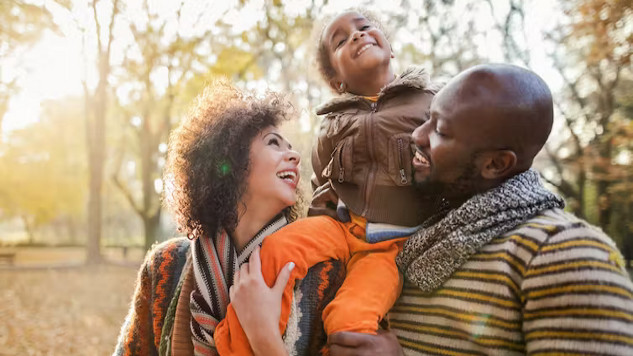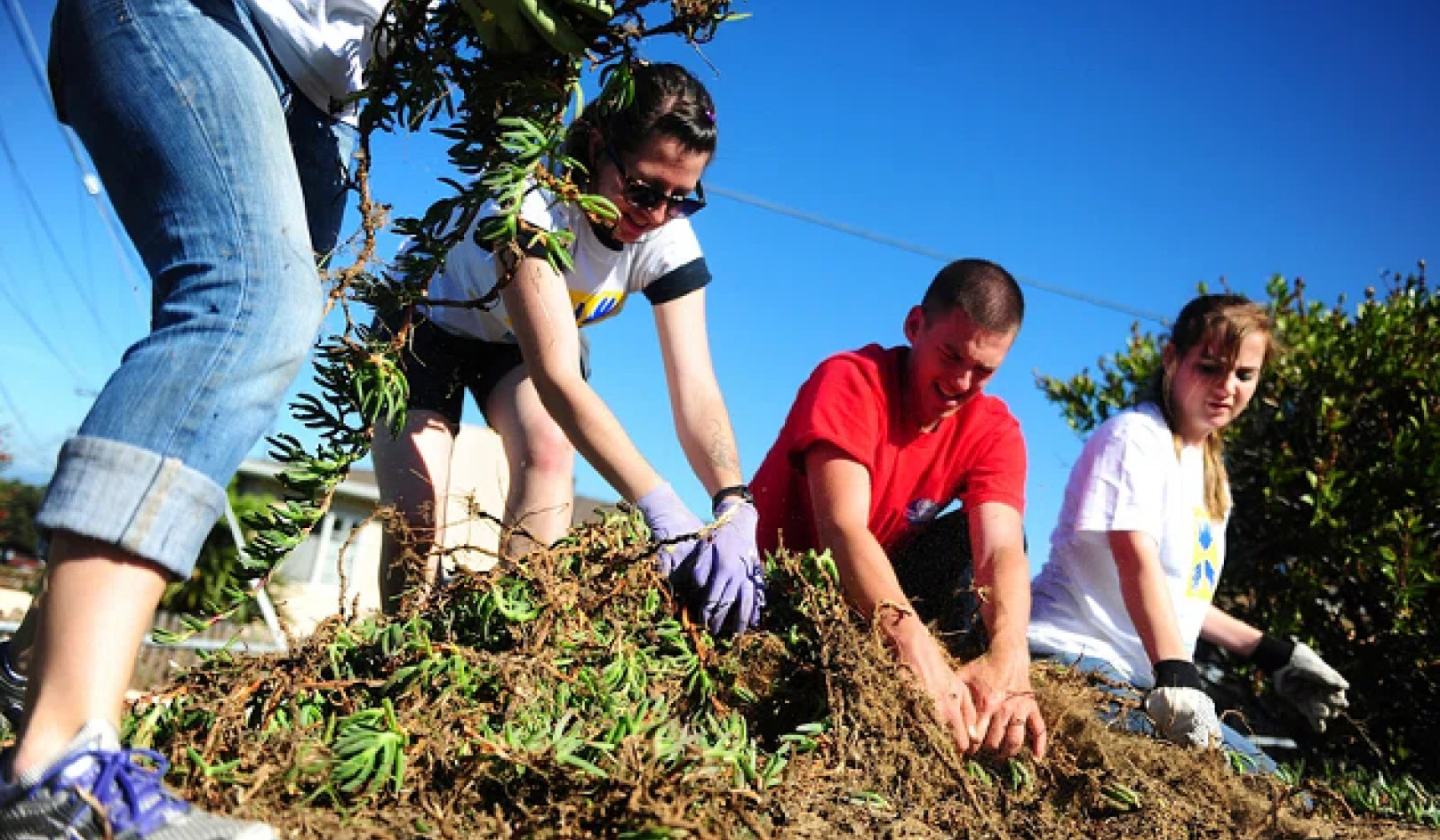
Strong, supportive relationships with moms, dads and nonparental caregivers are all vital. skynesher/E+ via Getty Images
Imagine a sudden rustle in the tall grass. A ripple of alarm passes through the group of early humans who live together amid ancient, rugged terrain. In the center of the encampment, a 3-year-old child – let’s call her Raina – stumbles and falls, her eyes wide with fear.
Without hesitation, her mother sweeps her up into her protective arms, while her grandmother quickly gathers herbs and leaves to create a pungent smokescreen to deter lurking predators. Simultaneously, Raina’s father and uncles move swiftly to the outskirts of the camp, their vigilant eyes scanning for signs of danger.
In this heart-pounding moment, Raina was enveloped in a web of care. Multiple caregivers worked seamlessly together, their collective efforts serving as a shield against the unknown threat that lurked beyond the safety of their campfire’s glow. It took a village to ensure Raina’s safety.
For at least 200,000 years, children grew up in a similar setting to Raina’s: a social environment with multiple caregivers. But 20th-century child psychologists placed almost exclusive importance on the mother-child bond. Research on children’s attachment relationships – the emotional ties they develop with their caregivers – and how they influence child development has had a mother-centric focus. Academic psychology’s emphasis on the child-mother relationship can be at least partly attributed to social norms about the appropriate roles of mothers and fathers. Whereas fathers have been characterized as the breadwinners, mothers have been thought of as more involved in the daily care of children.
We are clinical-developmental psychology and child and family researchers interested in studying how the quality of child-caregiver relationships affects children’s development. With 29 other researchers, we started a research consortium to study children’s attachment relationships. Together, we ask: How does having attachment relationships to both mothers and fathers affect children’s socioemotional and cognitive outcomes?
Mother-centric attachment research
Children develop attachment relationships with people whose presence around them is stable over time. For most children, these people are their parents.
Social scientists broadly classify attachment relationships as secure or insecure. A secure relationship with a specific caregiver reflects a child’s expectation that when they’re alarmed – as when emotionally or physically hurt – this caregiver will be available and emotionally supportive. In contrast, children who are uncertain about the availability of their caregivers in times of need are likely to form an insecure attachment relationship.
In the U.S. and Europe, where most attachment research has been conducted to date, the primary caregiver was frequently assumed to be the mother. Accordingly, researchers have almost exclusively focused on mothers as attachment figures. Mothers were also more accessible for researchers, and they more readily consented to participate in studies than fathers and nonparental caregivers such as grandparents and professional caretakers.
Furthermore, many researchers have assumed that there is a hierarchy within parental caregiving, wherein attachment with mothers is more important for understanding children’s development than attachment with caregivers considered “secondary,” such as fathers.
Already by the late 1980s, some scholars recognized the need to assess the joint impact of children’s attachment relationships with multiple caregivers on their developmental trajectories. But little research ensued. Recently, we revived such calls and proposed models that researchers can use to systematically assess the joint effects of children’s attachment to both mothers and fathers on an array of developmental outcomes.
Then, we recruited more than two dozen social scientists from eight countries who are interested in these questions around attachment relationships. Together, we formed the Collaboration on Attachment to Multiple Parents Synthesis consortium.
The more secure attachments the better
The first step our group took was compiling data collected by attachment researchers across the globe over the past 40 years. We identified previous research on the attachment relationships of more than 1,000 children with both their parents.
Instead of categorizing children as securely versus insecurely attached to one parent, we placed them into one of four groups:
- Children with secure attachment relationships to both mother and father.
- Children with secure attachment to mother and insecure attachment to father.
- Children with insecure attachment to mother and secure attachment to father.
- Children with insecure attachments to both parents.
In two separate studies, we assessed whether the children’s attachment to mother and father predicted mental health and language competence. In these studies, children’s attachment relationships were assessed by observing how they behaved during brief separations from each parent – for instance, in what psychologists call the strange situation procedure.
We found that children who simultaneously had secure attachment relationships with both mothers and fathers were likely to experience fewer symptoms of anxiety and depression and to exhibit better language skills than kids with one or no secure attachment relationships within their intact, two-parent families.
How might a child’s network of attachment relationships have these effects? While we couldn’t assess it in our study, there are various plausible mechanisms at play. For instance, think about a child with two secure attachment relationships to both mother and father who has trust in both parents that they will be there in challenging situations.
All children encounter sadness, anger and despair. But because a child with dual secure attachments can readily turn to their parents for help and support, negative emotions may be resolved quickly and not turn into defiance or depression. Because they have less of a need to monitor their parents’ whereabouts, this child may also be more adventurous and exploratory, giving them experiences to share and talk about. They might be exposed to a wider range and amount of verbal expression – helping expand their language skills.
Mothers aren’t the whole story
It is also important to note what we did not find: There was no hierarchy of importance in terms of which parent a child developed a secure attachment with. Children with secure attachment only to mothers (but not to fathers) and children with secure attachment only to fathers (but not to mothers) were not statistically different in their mental health and language competence outcomes.
These findings support an important takeaway: Mothers and fathers are equally important in raising children and setting them up for optimal developmental trajectories. In other words, it is the number of secure attachment relationships a child develops within the family network – not the specific gender of the adult with whom a secure relationship is developed – that matters.
Children have also been shown to thrive when developing secure attachment relationships in nontraditional families, such as those with same-sex parents. We thus expect that future studies will replicate our findings in nontraditional two-parent families.
Future research should also investigate other family networks that include nonparental caregivers, such as grandparents, who often take an active role in rearing children. In collectively oriented cultures, family households often comprise a wider network of attachment figures than the traditional two-parent households often found in the U.S., Canada and Europe. Studies in these cultures are likely to find that attachment networks may be more pertinent than research on single relationships when it comes to understanding children’s mental health and academic skills.
As the African proverb goes, it takes a village to raise a child. We are all descendants of children like Raina. Our findings highlight the critical need to adjust policy and early intervention efforts to support the parent couple and potentially other configurations of stable caregivers – not just mothers.![]()
Or Dagan, Assistant Professor of Clinical Psychology, Long Island University Post and Carlo Schuengel, Professor of Clinical Child and Family Studies, Vrije Universiteit Amsterdam
This article is republished from The Conversation under a Creative Commons license. Read the original article.

Related Books:
Here are 5 non-fiction books on parenting that are currently Best Sellers on Amazon.com:The Whole-Brain Child: 12 Revolutionary Strategies to Nurture Your Child's Developing Mind
by Daniel J. Siegel and Tina Payne Bryson
This book provides practical strategies for parents to help their children develop emotional intelligence, self-regulation, and resilience using insights from neuroscience.
Click for more info or to order
No-Drama Discipline: The Whole-Brain Way to Calm the Chaos and Nurture Your Child's Developing Mind
by Daniel J. Siegel and Tina Payne Bryson
The authors of The Whole-Brain Child offer guidance for parents to discipline their children in a way that promotes emotional regulation, problem-solving, and empathy.
Click for more info or to order
How to Talk So Kids Will Listen & Listen So Kids Will Talk
by Adele Faber and Elaine Mazlish
This classic book provides practical communication techniques for parents to connect with their children and foster cooperation and respect.
Click for more info or to order
The Montessori Toddler: A Parent's Guide to Raising a Curious and Responsible Human Being
by Simone Davies
This guide offers insights and strategies for parents to implement Montessori principles at home and foster their toddler's natural curiosity, independence, and love of learning.
Click for more info or to order
Peaceful Parent, Happy Kids: How to Stop Yelling and Start Connecting
by Dr. Laura Markham
This book offers practical guidance for parents to shift their mindset and communication style to foster connection, empathy, and cooperation with their children.























